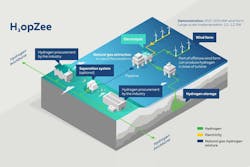Neptune, RWE to accelerate green hydrogen production in Dutch North Sea
Neptune Energy and RWE agreed to jointly develop H2opZee—an offshore green hydrogen project—ahead of 2030.
H2opZee is a demonstration project which aims to build 300-500 megawatts (Mw) electrolyzer capacity in the North Sea to produce green hydrogen using offshore wind. The hydrogen will then be transported to land through an existing pipeline with 10-12 Gw capacity.
A feasibility study is expected to begin in second-quarter 2022. The project is an initiative of TKI Wind op Zee, an initiative supported by the Dutch government.
Future energy supply, decarbonization
H2opZee consists of two phases. The first includes the feasibility study and setup of an accessible knowledge platform, Neptune said in a Feb. 15 release. The objective is to start roll-out of hydrogen at sea in the Netherlands. Implementation is expected to occur in the second phase. A tender methodology is not yet defined.
Green hydrogen can play a role in future energy supply, and the energy transition can be “faster, cheaper and cleaner if we integrate existing gas infrastructure into new systems,” said Lex de Groot, managing director, Neptune Energy.
The company will apply lessons learned from PosHYdon—the world's first offshore hydrogen pilot on a working platform—to H2opZee, he said (OGJ Online, July 22, 2021).
“The faster we can scale up green hydrogen at sea, the faster industries such as chemicals and steel production can become more sustainable,” he said.
About the Author
Mikaila Adams
Managing Editor, Content Strategist
Mikaila Adams has 20 years of experience as an editor, most of which has been centered on the oil and gas industry. She enjoyed 12 years focused on the business/finance side of the industry as an editor for Oil & Gas Journal's sister publication, Oil & Gas Financial Journal (OGFJ). After OGFJ ceased publication in 2017, she joined Oil & Gas Journal and was later named Managing Editor - News. Her role has expanded into content strategy. She holds a degree from Texas Tech University.

